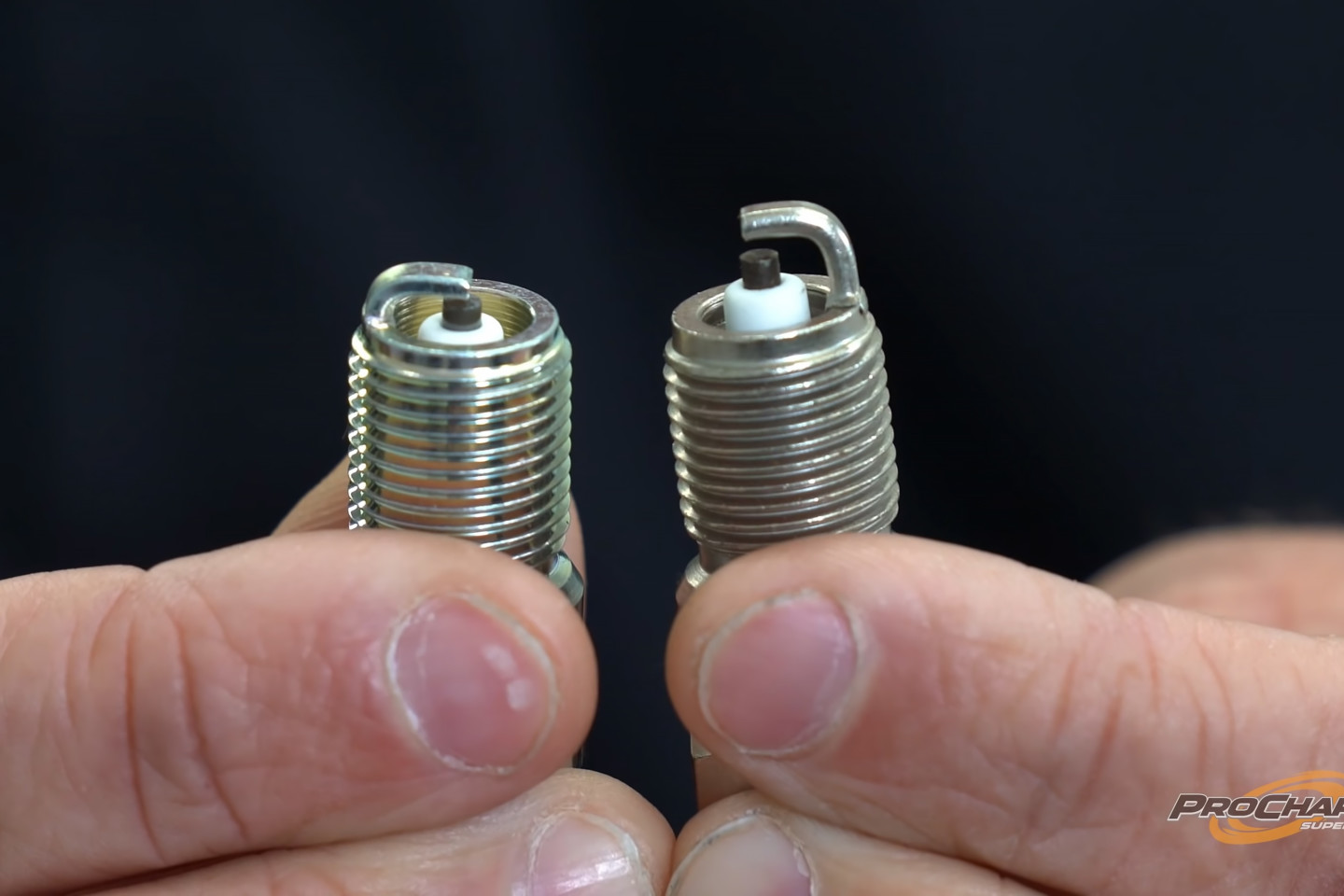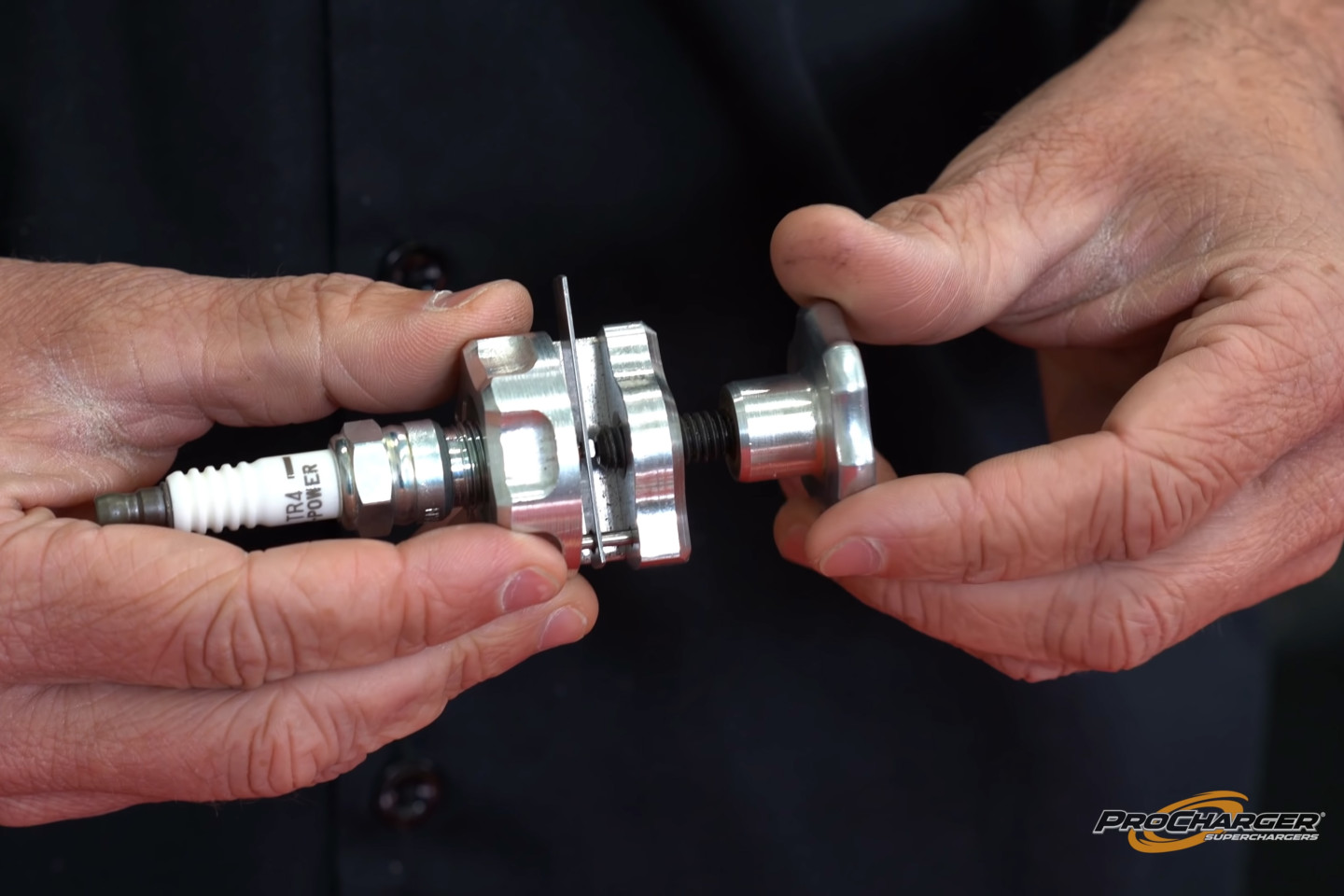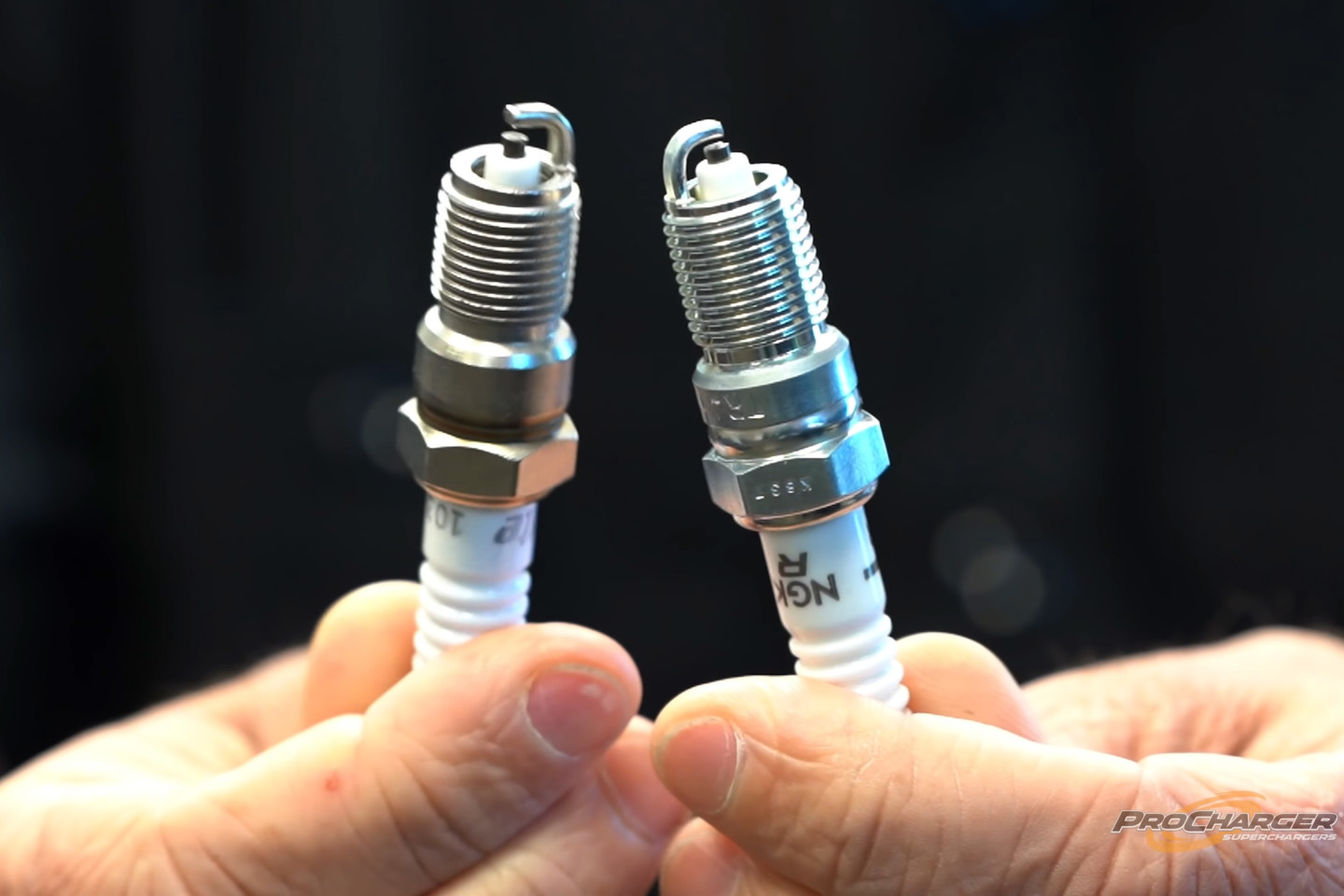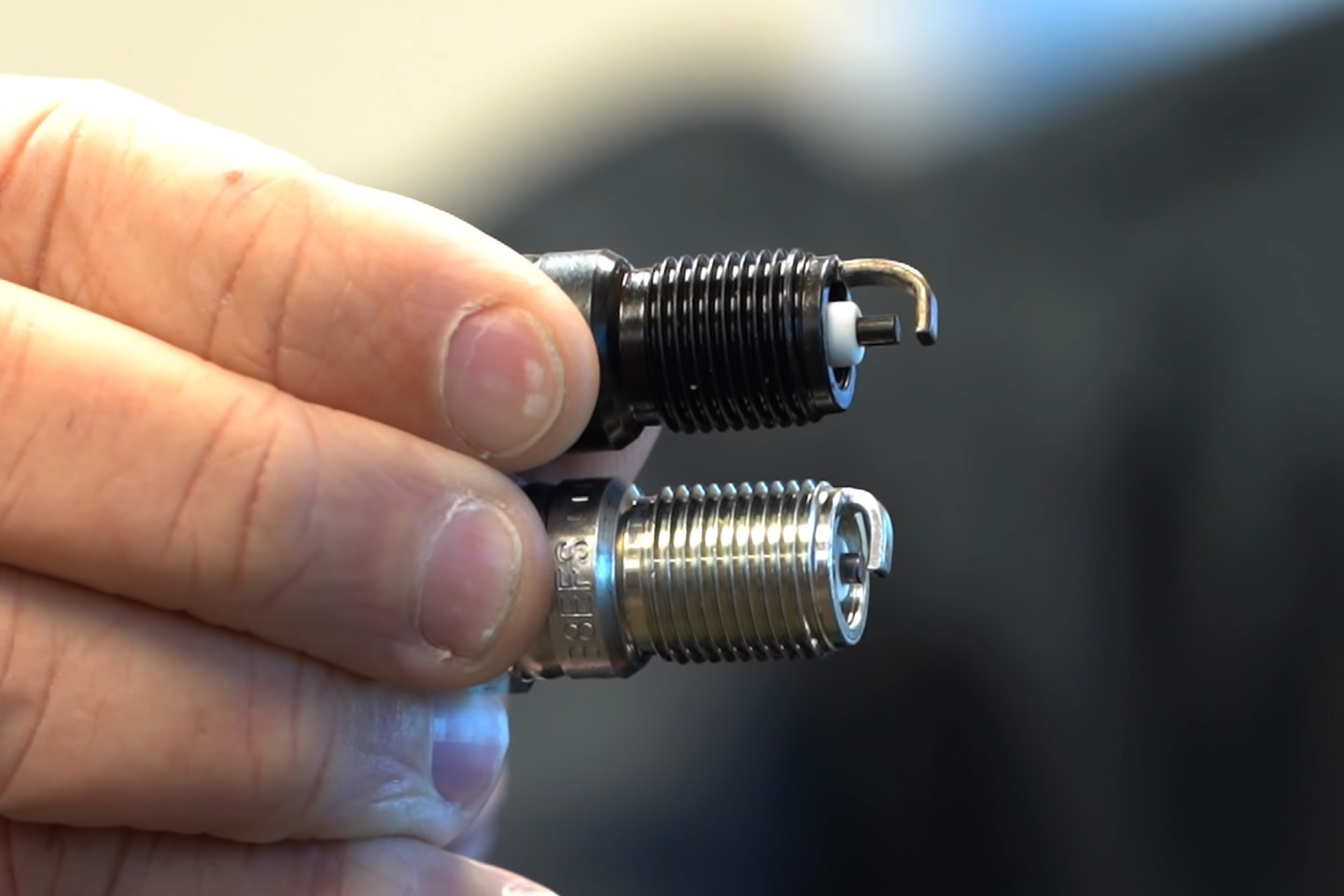We’ve discussed the spark plug a lot before, like here and here but, one thing we haven’t really touched on is supercharger-specific spark plug needs. Luckily for us, ProCharger has, in the above video with Erik Radzins, Director of Communications and Calibrations.
There are a lot of complexities with choosing the right spark plug for a given application, but this segment, which has been dubbed “ProCharger 101,” easily breaks down the key points of consideration when choosing spark plugs in a supercharged, street-car application. As the 101 moniker suggests, this is a basic overview, and you can dive deeper into each of the subjects individually, separately from this article.
Spark Plug Heat Range
The first subject broached is the proper heat range of a spark plug in a supercharger application. Common knowledge says that you want a colder plug when you supercharge a car, but what, exactly does that mean. “Heat Range is the spark plug’s ability to pull heat out of the chamber, away from the electrode tip,” Radzins explains.
If the plug gets too hot during the operation of the engine, it can act as a source of pre-ignition of the air-fuel charge. To remedy that, you go to a “colder plug” in the increased-cylinder-pressure environment. But, as always, there can be too much of a good thing. “If you go too cold though, you can get idle misfires, a lack of power, and drivability problems. Sure, it’s a different deal for a 2,000-horsepower drag car being run for 30 seconds at a time, but here, we’re talking about street cars making 1,000 horsepower or less,” Radzins says.
Plug Gap For Blower Applications
When you add a supercharger, in addition to a different heat range, you’re going to want to gap your plugs differently as well. As Radzins explains, “By adding a supercharger, you’re adding cylinder pressure. When that spark has to jump from the ground strap to the electrode, the additional cylinder pressure makes that harder to do. To ensure that it fires a spark with the same ignition voltage as before, we close down the gap to make it a little bit easier for it to make the jump.”
Sometimes referred to as “spark blowout,” eliminating it without increasing spark energy (by adding an upgraded ignition system) is as simple as closing the gap. “ProCharger recommends .028 to.032 inches for the average 600 to 800 horsepower combination,” says Radzins. But, in some cases like the Coyote, ProCharger recommends as little as .018 to .022 inches for high-power applications. The ultimate goal is to make the gap as large as you can (reliably with your ignition system) for the biggest possible spark.

With no other changes to your vehicle, you’re going to want to go with a spark plug that is colder than OEM, and reduce the spark gap. The additional cylinder pressure of supercharging adds both heat and pressure to the mix, so you’ll need to account for both.
So, how do you properly gap plugs? Well, Radzins explains that, saying, “There’s a great way to gap your spark plug, a good way to gap your spark plug, and a please-don’t-ever-do-that way to gap your spark plug.” We’re sure there are plenty of you who have gapped plugs using the latter method (we’ll plead the fifth on that one).
“The right way is to use a screw-down tool to close the distance between the ground strap and electrode,” says Radzins. “The good way uses a common gapping tool, where you push and lever down on the ground strap to close the gap. The worst method is to slam your spark plug on the ground. You want all of the gaps to be very even, and the last thing you want to do is slam a spark plug onto a solid surface.”

This is the purpose-built tool designed to close the gap on a spark plug. the screw applied pressure to the ground strap while the feeler gauge acts as a stop to get the right gap.
Just The Tip
If you’re coming from the modern late-model performance world “tip style” probably doesn’t mean much to you, in the way of sparkplugs. “Coyotes, Hemis, and LS engines all use a pretty similar standard spark plug tip design,” says Radzins. “But, when you get into small-block Fords and small-block Chevys, every cylinder head has its own plug location and depth in the cylinder head. That means that the tip design is crucial.”
Having the wrong length spark plug can be both thread length and tip protrusion via standard or “projected tip” lengths. “The tip protrusion needs to be such that it sits in the air-fuel mixture. Refer to the cylinder head manufacturer and the spark plug manufacturer to make sure you’re using the right plug design, Radzins says. We’ve touched on that some here.
In addition to the style of the tip, some confusion arises around the material the tip (or conductor) of the plug is made from. “People are concerned about the different tip materials and running hotter or colder than another. Not the case. Platinum, double-platinum, and iridium plugs were designed by manufacturers to go 100,000 miles without a spark plug change. The electrode materials are simply stronger than traditional copper so they wear less,” Radzins explains. Another benefit to being made from a stronger material than copper, the electrode tip can also be made smaller, to assist the spark in jumping the gap, without a noticeable decrease in lifespan.
Resistance Isn’t Futile
Resistor spark plugs are exactly what they sound like — spark plugs with a resistor built into them. They were developed in the ’60 to reduce RFI by lowering the energy of the spark. “If you put new plugs in the engine, and now all of a sudden your radio sounds funny, or you have a datalogger that won’t log properly, or the engine is breaking up and misfiring. Chances are, you bought a plug without a resistor,” says Radzins.
“You can’t tell them apart just by looking at them; you have to find out from the manufacturer. Anything modern, with a radio, an EFI system, a datalogger, or anything electronic on board, means you’re going to want a resistor-style plug. If you’re old-school, carbureted, and don’t have any electronics on board, cool. You can get away with a non-resistor plug, although there is no disadvantage to running a resistor plug.”

You can’t tell whether a plug is a resistor-style or not just by looking at it. Chances are, if you are running electronics in the car, you’ll want a resistor-style plug.
Additionally, Radzins recommends that proper spark plug wire maintenance be part of your routine. “Every time you pull your spark plug wires off of the plug or coil, you run the risk of breaking the wiring internally. They are cheap to replace, so you should really consider changing them when you change your plugs, so then you don’t have to worry about misfires caused by the wires.”
Reading Your Plugs
Reading your plugs can be considered to be voodoo by some (we discuss reading plugs with different fuels here) but it’s not hard. What is usually challenging is creating the environment to read a plug properly. “Spark plugs aren’t time machines. They are not recording devices. The plugs will not tell you what has been happening over the past month,” says Radzins.
“To properly read plugs, you need a whole lot of new plugs, and to be on a dyno or at a track. The way you read the plug is that you put a brand-new set of plugs in, make a dyno pull, and shut the car off at the very top of the pull. Then you can read the spark plug and it will tell you what happened right before the engine was shut off. Same thing at the track. Put your new plugs in, make your pass and shut the engine off through the traps, and then read your plug on the return road.”
You don’t need to be an expert to understand spark plugs. As Radzins points out, some common sense and a basic understanding of what the plugs can and can’t do will put you ahead of the game when it comes to choosing the right plug.

Ultimately, your goal is to have the widest gap that your ignition system and cylinder pressure will allow for. As those change, so will your ideal spark plug gap.



















